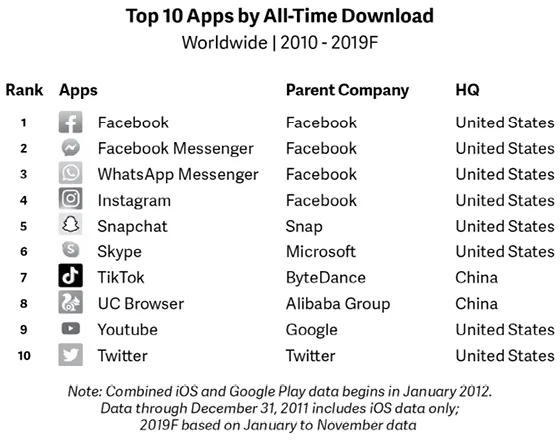![]()
PART I
![]()
Chapter 1
The year is 2020. The topic is mobile apps. And we’re starting with an app that’s burst onto the scene in unprecedented ways: TikTok.
Yes, that TikTok—the trendy viral video-sharing platform that’s captivated Gen Z with its instant meme culture and quirky content. It’s also the very same TikTok that’s dominated international discourse thanks to privacy concerns, proposed bans, and lawsuits against the White House!
So, let’s not underestimate it. After all, how many apps have lofted unknown rappers to the number one spot on Billboard’s Hot 100? How many apps have generated their own unique language of humor? How many apps have crashed onto the all-time download leaderboards?
Actually, let’s answer that last one.
Yeah, TikTok is that popular. Two plus billion downloads, despite only hitting the scene in late 2016. Today, its brand name is quickly entering the American lexicon alongside your Ubers and Skypes.
The gist of the platform is this: You create and watch short-form videos with audio, often incorporating dancing, lip-syncing, or silly sketch bits. Others can then react to or even build off your content, cultivating what the app calls an exciting, spontaneous, and genuine atmosphere.
We will get into the other pertinent details, but, for the time being, it really is that simple. And yet, in a few short years, it has launched its parent company ByteDance up to an approximate $140 billion net worth. Big names like Instagram, Facebook, and YouTube are all working on competitive products to take a bite of this market share.
Somehow, someway, Zhang Yiming, the billionaire founder behind ByteDance and TikTok, has tapped into something that’s resonated with users, at least for now. How did they emerge from a dense sea of aspiring apps? And what can they do to stay afloat?
Starting with The Good: How TikTok has found success?
On the surface, TikTok may look a lot like its video-centric predecessors. Remember Vine? That short video social platform from a few years back?
If you don’t, it’s because Vine notoriously burned out with a shortsighted business plan. TikTok, on the other hand, has gone the extra mile to win over users and secure profits. Here’s how:
It knows how to bring everyone together
Based primarily in music, dance, and humor, TikTok crosses cultures and languages with an ease that most social apps simply can’t enjoy. And the developers have played into this sense of community, enabling a degree of interaction and content aggregation that Vine never did.
What you end up with are the app’s Duet and React features, which let users engage in playful back-and-forths. These seemingly minor details go a long way in establishing your app’s purpose (see Chapter 3).
It makes things personal. In a good way
TikTok’s AI algorithms examine your content viewed and hashtags used to customize your feeds with tailor-made suggestions. Unlike other social media websites where you have to like and follow topics, TikTok does so in an expertly nonintrusive fashion. As The New Yorker’s Jia Tolentino so eloquently puts it:
“Some social algorithms are like bossy waiters: they solicit your preferences and then recommend a menu. TikTok orders you dinner by watching you look at food.”
The never-ending cycle of collecting user data and refining recommendation algorithms—that’s ByteDance’s bread and butter. And we’ll dig into the main course in Chapter 6.
It’s easy as pie and full of flavor
Finding snippets of your favorite songs takes just a few seconds. Recreating any dance challenge video is a breeze. The whole platform, for that matter, is incredibly intuitive, bottling down the complexities of video creation into a casual pastime. All you need to bring are killer dance moves.
That said, easy-to-use doesn’t mean bare bones. TikTok is full of features that Vine lacked: Visual filters, sound effects, longer recording options, etc.. . . combined with the interface’s simplicity, this versatility offers a transformative Interaction Design (IxD)—something we’ll further explore in Chapter 5.
It gets its audience. And how to speak to them
We already have highly political Twitter and fake news Facebook. We already have YouTube, dominated by established names and advertisers.
Now we have simple, goofy, irreverent TikTok, according to TechCrunch. The New York Times calls it “the only truly pleasant social network in existence.” Free of news and full of supportive, jovial spirit, TikTok empathizes with the needs and wants of its overwhelming Gen Z audience (more on this in Chapter 4).
Not only does the app understand its users, but it also effectively communicate...

